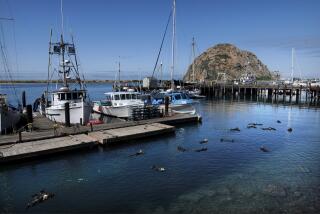Dead Sea Snails Wash Ashore : Officials Reassess Oil Spill Damage
- Share via
Dead sea snails that washed ashore in Seal Beach indicate that an oil spill caused by a leaking pipeline may be more serious than originally thought, officials said Thursday.
A spokesman for the state Department of Fish and Game said the snails, which are not an endangered species, were the only sea life affected so far. But, spokesman Curt Taucher added, crude oil “can stick to the feathers of birds. And with abalones and sea snails, it acts as a hindrance to their mucous membranes.”
Fish and Game workers were assessing the damage Thursday afternoon, Taucher said.
“We probably won’t have clear evidence until Friday, but it looks like around four or five miles (of ocean) have been affected,” he said. Authorities said Wednesday that the spill had contaminated three miles of ocean.
Beaches from Anaheim Bay to Belmont Pier in Long Beach, which were closed Wednesday, were expected to be reopened today.
The Exxon Co. pipeline that ruptured 100 yards offshore extends from a drilling and production facility on Belmont Island, 1 1/2 miles southwest of the Seal Beach Pier, to a processing plant in Seal Beach. The leak, at the base of the 20-year-old platform, was spotted by a resident Wednesday morning.
Authorities had said Wednesday that the spill appeared to present no danger to wildlife or the environment.
On Thursday, Steven Wong, Orange County environmental assistant health director, said the oil may have caused environmental problems. “We have not received any confirmations on it yet, but it is still something we have to determine.”
But Dennis Kelly, a biology professor at Orange Coast College who studies marine and wildlife on the county’s beaches, said the oil spilled Wednesday “doesn’t seem like a whole bunch. Animals are pretty resistant unless they are completely covered in oil.”
Marine Biologist Called
Exxon called in a marine biologist Thursday to examine the situation, said company spokeswoman Carrie Chassin.
The company estimated that about 420 gallons of oil mixed with sea water leaked from the pipeline, but only 125 gallons of that was crude oil, said Vern Gaede of the oil and gas division of the state Department of Conservation.
Gaede said the spill was minor, and “really just created a hell of a sheen.”
“We inspected that pipeline on April 8, and everything was fine,” he said.
Chassin said the platform is one of two on Belmont Island. Chevron owns the other, but it is not in operation. Chassin said the platform is relatively small, normally pumping only 1,300 gallons of crude oil per day. Some of Exxon’s platforms in Santa Barbara, she said, pump as much as 40,000 gallons of oil per day.
“This one is very minor,” she said.
Private Firms Hired
Exxon hired two private firms Wednesday to remove the oil. Workers from Clean Coastal Waters and IT Corp. Environmental Spill Response used a boom, a floating curtain that contains the oil, until it could be mopped up by highly absorbent pads.
About 70% of the oil had been removed by Thursday, Chassin said. “All of the oil in the water has been recovered,” she said. The remainder had reached the beaches and was expected to be cleaned up by Thursday night.
A spokesman from the U.S. Coast Guard in Long Beach said officials flew over the area Thursday and agreed that about 70% had been removed.
On Thursday, only a few joggers were on the beaches as work crews continued the cleanup.
Seal Beach officials had posted signs warning people to stay out of the water until the cleanup is over.
One Seal Beach resident who was jogging along the beach Thursday said he stopped swimming in the water long ago. “All the waters around here are pretty dirty,” Mike Verrecchia said. “What with the harbor, the channel and the nearby naval base, there is always something going on. I don’t go in the water.”
Eldon Alexander, who was strolling near the beach with his son, said this was the first spill he could remember in four years. “It is just one of those unfortunate circumstances caused by a weakness in the pipes.”
In April, 1984, about 800 gallons of oil leaked into the ocean from an offshore rig near Huntington Beach owned by Houston-based Aminoil USA. Small globules of tar washed up on more than a mile of Orange County coastline, but there was little or no damage to wildlife, state officials said. Coast Guard spokesman Charles Embleton said spills like these occur “six, maybe 10 times a year” in Southern California.
More to Read
Sign up for Essential California
The most important California stories and recommendations in your inbox every morning.
You may occasionally receive promotional content from the Los Angeles Times.










